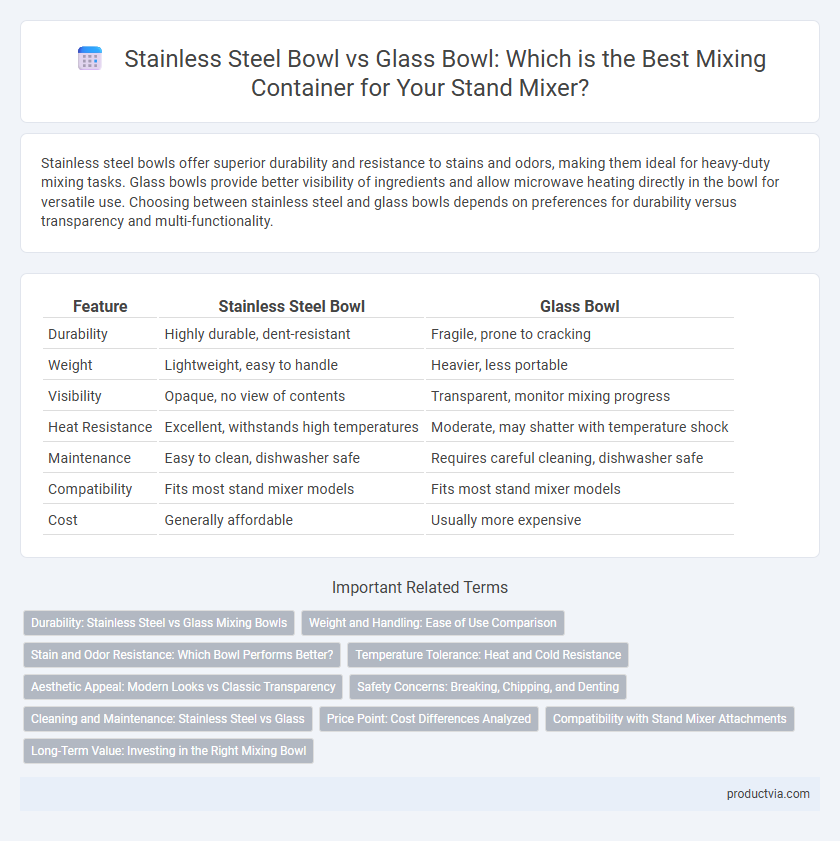Stainless steel bowls offer superior durability and resistance to stains and odors, making them ideal for heavy-duty mixing tasks. Glass bowls provide better visibility of ingredients and allow microwave heating directly in the bowl for versatile use. Choosing between stainless steel and glass bowls depends on preferences for durability versus transparency and multi-functionality.
Table of Comparison
| Feature | Stainless Steel Bowl | Glass Bowl |
|---|---|---|
| Durability | Highly durable, dent-resistant | Fragile, prone to cracking |
| Weight | Lightweight, easy to handle | Heavier, less portable |
| Visibility | Opaque, no view of contents | Transparent, monitor mixing progress |
| Heat Resistance | Excellent, withstands high temperatures | Moderate, may shatter with temperature shock |
| Maintenance | Easy to clean, dishwasher safe | Requires careful cleaning, dishwasher safe |
| Compatibility | Fits most stand mixer models | Fits most stand mixer models |
| Cost | Generally affordable | Usually more expensive |
Durability: Stainless Steel vs Glass Mixing Bowls
Stainless steel mixing bowls offer superior durability compared to glass bowls, as they resist breaking, chipping, and scratching during heavy use. Glass bowls, while visually appealing and non-reactive, are more prone to cracking or shattering under impact or extreme temperature changes. For long-term reliability in stand mixer use, stainless steel bowls provide a robust, unbreakable option ideal for frequent mixing and heavy-duty tasks.
Weight and Handling: Ease of Use Comparison
Stainless steel bowls are significantly lighter than glass bowls, making them easier to handle and maneuver during mixing tasks. Their lightweight design reduces strain on the mixer arm and allows for quicker bowl changes, enhancing overall kitchen efficiency. In contrast, glass bowls tend to be heavier and more cumbersome, which can affect ease of use and user comfort during extended mixing sessions.
Stain and Odor Resistance: Which Bowl Performs Better?
Stainless steel bowls outperform glass bowls in stain and odor resistance due to their non-porous surface that prevents absorption of food particles and odors. Glass bowls can retain stains and smells from acidic or strongly flavored ingredients, which may affect the taste of future mixes. The durability and ease of cleaning stainless steel make it the preferable choice for maintaining clean, odor-free mixing containers over time.
Temperature Tolerance: Heat and Cold Resistance
Stainless steel bowls exhibit superior temperature tolerance, handling both high heat and extreme cold without warping or cracking, making them ideal for tasks like whipping hot ingredients or chilling dough. Glass bowls provide good cold resistance and allow easy monitoring of contents through transparency but are vulnerable to thermal shock and can crack under sudden temperature changes. Overall, stainless steel offers greater durability for temperature variations during mixing processes.
Aesthetic Appeal: Modern Looks vs Classic Transparency
Stainless steel bowls offer a sleek, modern aesthetic with a polished finish that complements contemporary kitchen designs and resists staining or scratching. Glass bowls provide classic transparency, allowing users to visually monitor mixing progress and add a timeless charm to any countertop. The choice between stainless steel and glass mixing containers ultimately depends on whether a modern sophisticated look or clear visibility is preferred.
Safety Concerns: Breaking, Chipping, and Denting
Stainless steel bowls offer superior durability and resistance to breaking, chipping, and denting compared to glass bowls, making them safer for heavy-duty mixing tasks. Glass bowls, while visually appealing and allowing users to monitor mixing progress, are prone to shattering or chipping if dropped or struck, posing safety hazards. Choosing a stainless steel bowl for a stand mixer minimizes risks of injury and maintains integrity even under rigorous use.
Cleaning and Maintenance: Stainless Steel vs Glass
Stainless steel bowls offer superior durability and resist stains, making them easier to clean and maintain without retaining odors or discoloration. Glass bowls provide excellent visibility of ingredients but require careful handling to avoid scratches or cracks and may show stains more prominently. Both materials are typically dishwasher safe, but stainless steel bowls generally withstand frequent washing better, preserving their appearance and functionality over time.
Price Point: Cost Differences Analyzed
Stainless steel bowls for stand mixers typically cost more upfront due to their durability and resistance to stains and odors, providing long-term value despite the higher price. Glass bowls are generally more affordable but can be prone to chipping or breaking with frequent use, adding potential replacement costs over time. Choosing between the two depends on budget considerations and the balance of initial investment versus longevity and maintenance expenses.
Compatibility with Stand Mixer Attachments
Stainless steel bowls offer superior compatibility with stand mixer attachments due to their durability and resistance to damage from mixing beaters and dough hooks. They provide a secure fit and maintain stability during high-speed mixing, preventing wobbling or slipping of attachments. Glass bowls, while aesthetically pleasing and non-reactive, are more prone to cracking and may not accommodate certain attachments as securely, limiting their effectiveness with powerful stand mixers.
Long-Term Value: Investing in the Right Mixing Bowl
Stainless steel bowls for stand mixers offer superior durability and resistance to scratches and stains, ensuring long-term value for frequent bakers and chefs. Glass bowls provide the advantage of visibility, allowing you to monitor mixing progress, but they are more prone to chipping and breakage over time. Investing in a stainless steel bowl maximizes longevity and maintains performance, making it the ideal choice for sustained use in a busy kitchen.
Stainless steel bowl vs Glass bowl for mixing container Infographic

 productvia.com
productvia.com